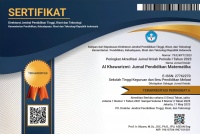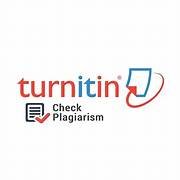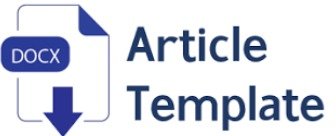KEMAMPUAN PEMECAHAN MASALAH PADA PANJANG SISI SEGITIGA
DOI:
https://doi.org/10.46368/kjpm.v1i2.435Abstract
References
Sugiyono.2019. Metode Penelitian
Kuantitatif, Kualitatif dan
R&D. Bandung: Alfabeta.
Sukirman, dkk. 2011. Matematika.
Cet.11: ed.1. Jakarta:
Universitas Terbuka.
Agsya, Feni Maisyaroh dkk. 2019.
Analisis Kemampuan
Pemecahan Masalah ditinjau
dari Motivasi Belajar Siswa
MTS. Pasundan Journal of
Research in Mathematics
Learning and Education
Volume 4 Nomor 2, 30
Desember 2019 ISSN 2548-
Jayusman, Iyus & Oka Agus.K.S. 2020.
Studi Deskriptif Kuantitatif
Tentang Aktivitas Belajar
Mahasiswa Dengan
Menggunakan Media
Pembelajaran Edmodo Dalam
Pembelajaran Sejarah. Jurnal
Artefak. Vol.7. No. 1. April
Lestari, Sri Wati Wahyu dkk. 2021.
Kemampuan Koneksi
Matematis pada Konsep Sinus.
Jurnal Pendidikan
Matematika. Al-Khawarizmi.
Januari 2021. STKIP Melawi
Mariam, Shinta dkk. 2019. Analisis
Kemampuan Pemecahan
Masalah Matematis Siswa
MTsN dengan Menggunakan
Metode Open Ended di
Bandung Barat.Jurnal
Cendekia: Jurnal Pendidikan
Matematika. Vol.3. no.1. Mei
pp. 178-186
Sarassanti, Y. & Mutazam. 2019.
Analisis Kemampuan Berfikir
Kreatif Matematis Mahasiswa
PGSD Pada Materi Bangun
Ruang Di STKIP Melawi.
Jurnal Pendidikan Dasar. 137
Trisnaning, Tri Wijayanti dkk. 2017.
Penerapan Pendidikan
Karakter Melalui Metode
Kooperatif Tipe Learning
Together untuk Meningkatkan
Hasil Belajar Mata Pelajaran
Fisika Siswa SMA Negeri 1
Semarang.Jurnal Profesi
Keguruan 3 (2) 2017:189-196
Darma, Yudi. 2017. Analisis
Metakognisi Terhadap
Pemecahan Masalah dalam
Materi Kaidah Pencacahan
pada Siswa Kelas XII IPS 1
MAN 1 Kubu Raya. Prosiding:
Jurnal Seminar Nasional
Pendidikan MIPA dan
Teknologi, 438
Downloads
Published
How to Cite
Issue
Section
Citation Check
License
Authors who publish with this journal agree to the following terms:
1. Authors retain copyright and grant the journal right of first publication with the work simultaneously licensed under a Creative Commons Attribution License that allows others to share the work with an acknowledgement of the work's authorship and initial publication in this journal.
2. Authors are able to enter into separate, additional contractual arrangements for the non-exclusive distribution of the journal's published version of the work (e.g., post it to an institutional repository or publish it in a book), with an acknowledgement of its initial publication in this journal.
3. Authors are permitted and encouraged to post their work online (e.g., in institutional repositories or on their website) prior to and during the submission process, as it can lead to productive exchanges, as well as earlier and greater citation of published work.






